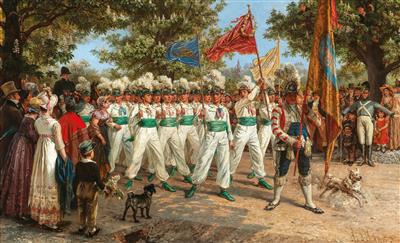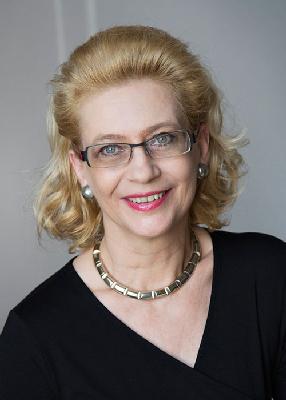Alois Schönn

(Vienna 1826–1897 Krumpendorf)
Parade of Runners on 1 May, after the Race in the Prater, signed A. Schönn, 132 x 204 cm, framed
Exhibited:
Viennese Annual Exhibition 1891
Provenance:
Dorotheum Vienna, 17 March 1949, lot 104, plate 16. Cafe Bürgertheater, 1030 Vienna;
Private Collection Vienna.
Catalogued in:
Friedrich von Boetticher, Malerwerke des 19. Jahrhunderts, Hofheim am Taunus 1979, vol. II, 2, p. 638, no. 68
Since the 17th century, there is evidence of so-called „runners“ in the Habsburg Empire, whose profession was facilitating the rapid transmission of messages over long distances. However, from the early modern period onwards, runner messengers became increasingly obsolete due to the establishment of the general postal system and better infrastructure. In Austria, and especially in Vienna, the „runner“ had a certain degree of international recognition, so that a development took place from the running messenger or lordly gala runner to a sporting discipline. The original function of a so-called runner was to run the carriage of the lordship and to clear any obstacles out of the way, carrying torches in the dark, and they were also messengers. In Vienna, these runners were probably organised in a guild since the end of the 18th century and were subject to an apprenticeship of several years, which they completed with a so-called „free run“. From the 18th century onwards, the runners also organised competitions or trial runs where an approximate distance of 18 km had to be covered. These runs were held annually in the Prater from 1822 and were included as an event in the May Festival.
Alois Schönn depicts such a running event in the present lot. The painter decided to reproduce the moment after a successfully completed competition. Thus the runners march in a solemn procession behind the guild standard, which usually led to a nearby coffee house where the participants had their well-earned breakfast. Schönn meticulously depicts the attire of the May 1 runners. This consists of a white jacket, white long trousers, white or green cap with a plume of feathers, and a sash or neckerchief. Also to be seen are the whips which the runners had placed around their necks to hold their hands to. Behind the bearer of the guild‘s standard, the runners, numbering about ten to twelve, are led by the winners. The fastest three to four participants received embroidered prize flags and prize money. On these prize flags, in addition to the embroidered rank numbers, there were different animal symbols that represented a certain rank depending on the speed of the animals: first rank a silver bird, second rank a golden stag, third rank a silver dog and fourth rank a golden rider. The flag of the first three ranks waving in the wind can be made out on the present lot. Alois Schönn skilfully picks up on the festive character of the running event in his large-format painting, which is probably based on a watercolour. A young lady has already hooked herself in the arm of a runner, so that the exuberant mood of the spectators is literally palpable.
Specialist: Mag. Dimitra Reimüller
 Mag. Dimitra Reimüller
Mag. Dimitra Reimüller
+43-1-515 60-355
19c.paintings@dorotheum.at
09.11.2021 - 16:00
- Estimate:
-
EUR 35,000.- to EUR 45,000.-
Alois Schönn
(Vienna 1826–1897 Krumpendorf)
Parade of Runners on 1 May, after the Race in the Prater, signed A. Schönn, 132 x 204 cm, framed
Exhibited:
Viennese Annual Exhibition 1891
Provenance:
Dorotheum Vienna, 17 March 1949, lot 104, plate 16. Cafe Bürgertheater, 1030 Vienna;
Private Collection Vienna.
Catalogued in:
Friedrich von Boetticher, Malerwerke des 19. Jahrhunderts, Hofheim am Taunus 1979, vol. II, 2, p. 638, no. 68
Since the 17th century, there is evidence of so-called „runners“ in the Habsburg Empire, whose profession was facilitating the rapid transmission of messages over long distances. However, from the early modern period onwards, runner messengers became increasingly obsolete due to the establishment of the general postal system and better infrastructure. In Austria, and especially in Vienna, the „runner“ had a certain degree of international recognition, so that a development took place from the running messenger or lordly gala runner to a sporting discipline. The original function of a so-called runner was to run the carriage of the lordship and to clear any obstacles out of the way, carrying torches in the dark, and they were also messengers. In Vienna, these runners were probably organised in a guild since the end of the 18th century and were subject to an apprenticeship of several years, which they completed with a so-called „free run“. From the 18th century onwards, the runners also organised competitions or trial runs where an approximate distance of 18 km had to be covered. These runs were held annually in the Prater from 1822 and were included as an event in the May Festival.
Alois Schönn depicts such a running event in the present lot. The painter decided to reproduce the moment after a successfully completed competition. Thus the runners march in a solemn procession behind the guild standard, which usually led to a nearby coffee house where the participants had their well-earned breakfast. Schönn meticulously depicts the attire of the May 1 runners. This consists of a white jacket, white long trousers, white or green cap with a plume of feathers, and a sash or neckerchief. Also to be seen are the whips which the runners had placed around their necks to hold their hands to. Behind the bearer of the guild‘s standard, the runners, numbering about ten to twelve, are led by the winners. The fastest three to four participants received embroidered prize flags and prize money. On these prize flags, in addition to the embroidered rank numbers, there were different animal symbols that represented a certain rank depending on the speed of the animals: first rank a silver bird, second rank a golden stag, third rank a silver dog and fourth rank a golden rider. The flag of the first three ranks waving in the wind can be made out on the present lot. Alois Schönn skilfully picks up on the festive character of the running event in his large-format painting, which is probably based on a watercolour. A young lady has already hooked herself in the arm of a runner, so that the exuberant mood of the spectators is literally palpable.
Specialist: Mag. Dimitra Reimüller
 Mag. Dimitra Reimüller
Mag. Dimitra Reimüller
+43-1-515 60-355
19c.paintings@dorotheum.at
|
Buyers hotline
Mon.-Fri.: 10.00am - 5.00pm
kundendienst@dorotheum.at +43 1 515 60 200 |
| Auction: | 19th Century Paintings |
| Auction type: | Saleroom auction with Live Bidding |
| Date: | 09.11.2021 - 16:00 |
| Location: | Vienna | Palais Dorotheum |
| Exhibition: | 29.10. - 09.11.2021 |
